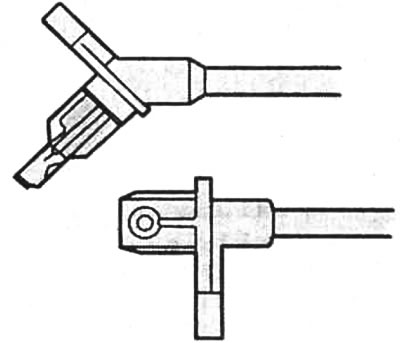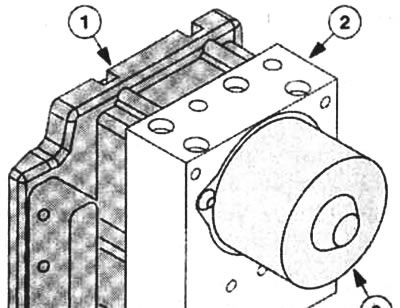ABS hydraulic module: it includes a pump with an electric drive and a distribution hydraulic box with solenoid valves. When you press the brake pedal, the brake pistons in the master brake cylinder push the brake fluid through the hydraulic distribution box to the wheels. At the same time, the hydraulic distribution box regulates the brake pressure in the brake pipes that connect each front wheel to the diagonally opposite rear wheel. When the ABS starts to work, the control unit sends a signal «reduce brake pressure». Brake fluid flows from the distribution box back to the expansion tank. If the brake pressure rises again, the brake fluid flows from the expansion tank through the hydraulic pump directly into the corresponding brake circuit. You notice the operation of the pump by a slight pulsation of the brake pedal.

ABS braking system: 1 - ABS hydraulic module; 2 - rear wheel sensor; 3 - front wheel sensor.
Wheel speed sensor: rigidly connected to the wheel hub at a short distance from the toothed disk (impulse wheel). The active wheel with its toothed elevations rotates depending on the rotation of the wheel (speed) past the sensor faster or slower. Each tooth of the impulse wheel induces a short burst of voltage. As a result, an alternating voltage appears in the sensor, which changes its frequency depending on the speed of the wheel. Sensors measure the speed of each wheel and transmit this information in the form of electrical signals to the control unit.

Each wheel is measured individually: the wheel speed sensors do not miss a single revolution. The ESP module draws a digital picture of the turning path based on the different clock frequencies of the speed sensors in the steering area
ESP module: The ESP module is located in the Focus on the ABS module type Mk20E-1 with TCS. The distribution hydraulic box has two additional valves, with which the rear wheels can be braked separately. The ESP module is in constant contact with the PCM via the SCP data acquisition bus.

ESP module: 1 - flanged electronic module; 2 - distribution hydraulic box; 3 - electric motor with high-pressure pump.
Longitudinal acceleration sensor: consists of two pendulum switches, which are installed under the center console. During normal movement, with slight acceleration or deceleration, they are at rest. If the deceleration or acceleration parameters programmed in the control unit are exceeded, the sensors transmit a corresponding signal to the control unit.
Malfunctions of the ABS brake system: when the ignition is switched on, the ABS brake system warning light comes on. When the engine is running, it goes out after no more than 2 s. If it lights up while driving, then there is a malfunction in the system. However, most of the time you can continue driving - albeit without a functioning ABS. Find a Ford workshop as soon as possible to check the system. In any case, as an amateur in the field of ABS, you can check the correct fastening of the plug connectors on the control unit, on the relay, wheel sensors and on the hydraulic module.
Visitor comments